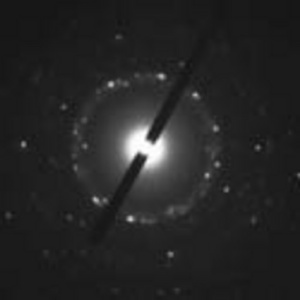Feb 19 2009
Materials typically expand when they are heated, which is why the concrete slabs in sidewalks can buckle on a hot day. Now, Kenichi Kato of the RIKEN SPring-8 Center in Harima and colleagues at Saga University and Japan's National Institute of Advanced Industrial Science and Technology have identified several materials that defy this common rule of thumb. In a paper published in Nature Nanotechnology, the team reports that nanoparticles of cupric oxide (CuO) actually shrink when they are heated*.
 The distance between the white spots in this electron diffraction pattern are inversely proportional to the distance between atoms in the CuO nanoparticles and will move closer together or further apart depending on whether the nanoparticles expand or contract, respectively, when they are heated.
The distance between the white spots in this electron diffraction pattern are inversely proportional to the distance between atoms in the CuO nanoparticles and will move closer together or further apart depending on whether the nanoparticles expand or contract, respectively, when they are heated.
To make the nanoparticles, Kato and colleagues started with large crystals of CuO and milled them down to particles approximately 5 nanometers in size. Using x-ray and electron diffraction, they measured the average distances between the atoms that make up CuO and how these distances vary with temperature. Starting from low temperatures (-253.15 °C), they found that CuO shrinks by about 1% from its original volume when it is heated to 200 K (-73.15 °C)—an effect that is several times larger than what is found in other materials that shrink when heated. With further heating, the nanoparticles started to expand.
The reason that materials, in general, expand when they are heated is that the atoms start to vibrate around their equilibrium positions as they gain energy and move away from one another. The opposite case—negative thermal expansion—can occur if the vibrations of some atoms actually pull other atoms together. For example, if an oxygen atom that bonds two metal atoms starts to vibrate perpendicular to this bond, it will pull the two metal atoms closer together. However, Kato and his colleagues believe that the negative thermal expansion in CuO nanoparticles may be related to this material’s magnetic properties, since the crossover from normal to negative thermal expansion in the nanoparticles occurs at the same temperature that the CuO orders magnetically.
This effect is also found in nanoparticles of the magnetic material manganese (II) fluoride (MnF2). “As the temperature is cooled and CuO orders magnetically, the magnetic Cu atoms begin to be aligned like a pair of bar magnets,” explains Xu-Guang Zheng from Saga University. “The two bar magnets push each other so that the distance between the two magnetic atoms expands.” Conversely, as the temperature increases, the Cu atoms push against each other less, leading to negative thermal expansion. Since this is a general argument, the team expects they will be able to find other magnetic materials in nanoparticle form that will exhibit negative thermal expansion.
*Zheng, X.G., Kubozono, H., Yamada, H., Kato, K., Ishiwata, Y. & Xu, C.N. Giant negative thermal expansion in magnetic nanocrystals. Nature Nanotechnology 3, 724–726 (2008).